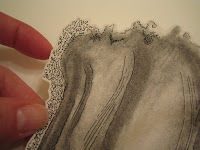LP wrote: "I love your blog - what great tips for anyone who's trying to create anything (like a new quilt or solve a problem in the middle of a quilt design)."
Thanks LP! This leads me to think of two new topics (threads)...one is "solving problems" and the other is "art and sewing circles". Since it's rather grey and cool where I am, and sewing circles make me feel warm and fuzzy, I'll start with that one.
First off, let me mention that I had thought about talking about quilts and realized how grossly uneducated I am to talk about them at all. I know they are lovely, amazing (and warm!) and can tell fascinating stories through the graphics they display and the painstakingly detailed workmanship that has gone into them. But I have never made a quilt or even attempted one...only a mock quilt which was made for a doll and that's another story. So I ask you, Oh Quilt Makers of the world - and I know you're out there -
What is one thing about making a quilt that makes you happy? Back to
groups and sewing circles...
Gathering together while working on a project gives a whole new meaning to the concept of sharing. I admit I haven't had as many sewing circle or art group experiences as I would like but as I talk to more and more artists I'm recognizing how valuable an experience it can be. Not only are you sharing your thoughts and stories, perhaps about what's going on in your life as well as your work, but you're also sharing your energy by encouraging someone else when they get stuck or are maybe feeling less motivated.
Is anyone out there part of any art group? Would you like to share a story about your group and how it got started? To be sure, there can be problems within groups...personalities and scheduling difficulties, I imagine...but let's face it, art is a community activity. Of course there are times when you want to work on something by yourself and aren't ready to share, but to me, it can be like watching a movie. You may watch the movie by yourself, but when it's done, do you find that you want to share it with someone? To ask them if they interpreted a scene the way you did or even caught something you didn't? Looking at art can be the same way (thanks to HB and AKD for helping me understand this). I guess that's what this blog can be for...
Talking about
solving problems is a good way to continue with the lines project. I often get stuck on a project, maybe it's just that I'm tired or maybe it's not coming out the way I had thought I wanted it to. This is tricky for me because I often don't have a finished image in mind (although I know many people who always know and sometimes I envy them) and all of a sudden I take that wrong turn into
what do I do now? and I can't get back to
oh, this can work. So, I started to build a list of things that may help if you find yourself in this same predicament. Please fee free to offer additional suggestions:
1. Step away from the paper (or canvas, or object). Take a deep breath, go for a walk, go have a coffee, come back and start a new, clean sheet
2. Chalk this one up to "an experiment" and keep going with it, just have fun and see what develops
3. Cut off the part that doesn't work for you and attach the rest of it to another piece
4. Use part of it for a collage
5. Turn it around or upside down and look at it from another angle
6. Start working with a completely new tool (this may not work if you're trying to master a tool, such a stylus or crochet hook, but if you're painting with a brush and you don't like what it's doing, try picking up a roller instead)
7. Listen to music
8. Do something unexpected...if you're working on a drawing try turning it into a 3-D image or sculpture
Does anyone have another idea??













